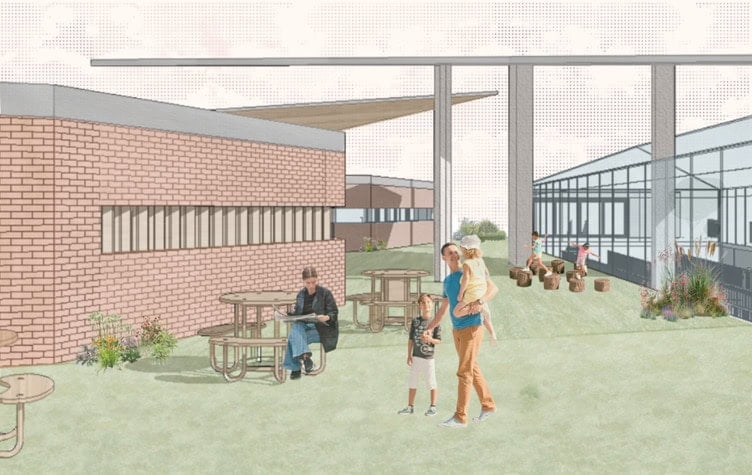Common Ground Rising: Maryam Khan’s Vision for Civic Renaissance in Glasgow
Rooting Tomorrow in Yesterday’s Foundations
For Maryam Khan, a recent Sheffield Hallam University graduate with a 2:1 in BSc Architecture, architecture is not just about space-making but about remaking the very frameworks of civic life. Her final-year project, a bold reimagining of civic infrastructure in Glasgow, stands testimony to this ethos—a synthesis of history, community, and climate awareness that proposes new ways of belonging and governance. As Maryam steps into the professional world, bringing with her not just academic distinction but a record of leadership and community engagement as a Hallam Rugby team member and 2023/24 Hallam Charity Fundraiser Award winner, her vision for civic architecture is both timely and necessary.
Reworking Ruins: Adaptive Reuse as Urban Memory
Set against the textured industrial past of Glasgow, Maryam’s project confronts the city’s layered identity head-on. Rather than viewing historic structures as relics or constraints, her proposal champions adaptive reuse, creatively weaving the memory of industrial sites into new civic purposes. Through careful preservation and striking modern interventions, familiar brickwork and metal trusses become scaffolds for a new kind of public assembly—a living link between yesterday’s labor and tomorrow’s collaboration.
The building, rather than erasing history, wears it proudly. Fragments of machinery are repurposed as public art; old walls are punctuated, not demolished, yielding to new forms but never abandoning the stories they contain. It’s not nostalgia for its own sake but a strategy for rooting Glasgow’s civic future in the authenticity that only accrued memory can offer.
Porosity, Participation, and Public Life
At the heart of Maryam’s proposal lies the idea of the building as a permeable, living artefact. Abandoning the archetype of the fortress-like town hall or exclusive administrative center, her architecture employs “porous spatial thresholds”—filtering rather than barring access. Layered courtyards, semi-open atria, and transparent façades blur the boundaries between city and institution, encouraging passersby to become participants, not mere spectators.
It is this radical openness that most defines the scheme. Spaces for education, protest, gardening, and governance do not exist in silos but overlap fluidly, producing the friction and synergy necessary for genuine participation. Here, citizens shape the agenda and the architecture shapes, in turn, a new type of citizenship—one anchored in trust, proximity, and constant dialogue.
Radical Sustainability: Nature as Stakeholder
As cities worldwide come to terms with accelerating climate change, Maryam’s approach to environmental design is not an afterthought. Her Glasgow intervention imaginatively integrates green infrastructure at every scale: rain gardens and green roofs temper the site’s microclimate, while open water channels recall the city’s canal heritage, improving stormwater management and enhancing biodiversity.
For Maryam, nature is both a resource and a stakeholder. Communal food-growing beds sit alongside spaces for activism and debate, foregrounding the principle that civic engagement extends to environmental stewardship. Material selection is strictly low-carbon and locally sourced where possible, signalling a commitment to the circular economy and demonstrating how large-scale civic projects can lead the way toward true ecological responsibility.
Civic Assembly as Living Artefact
Perhaps most compelling is the central conceit of the project: the civic building as an evolving artefact. The scheme deliberately builds in ambiguity—spatially and programmatically—so that the architecture can shift in response to collective use and changing societal needs. Walls are movable, zones can be reconfigured, and indoor-outdoor thresholds remain negotiable. In essence, the architecture institutionalizes the idea of assembly itself, not as a static event but as a perpetual process.
The community’s imprint on the building, from temporary installations to lasting renovations, is not just tolerated but actively facilitated. This commitment to radical transparency is furthered by glazed “governance galleries,” where public observation of council proceedings is effortless, and landscaped ramps invite all comers to take part, whatever their physical ability or background.
Empowering the Next Generation of Civic Leaders
Maryam Khan’s work resonates with the urgency and optimism so characteristic of the best student projects but stands out for its maturity and pragmatism. Her determination, resilience, and commitment to development, evident both in her academic achievements and her extracurricular contributions, shine through every aspect of this proposal. By foregrounding participation, embedded memory, and radical sustainability, she has delivered a vision of civic architecture that invites collective authorship and continuous evolution.
Connect with Maryam Khan
As Maryam seeks a Part 1 Architectural Assistant role, she brings with her a strong portfolio of ideas, leadership experience, and a passion for transforming communities through design. To discuss her project further, connect about potential collaborations, or explore opportunities, you can connect with Maryam Khan on LinkedIn or reach out directly via email at k1maryamk@gmail.com.
Maryam’s “common ground” is more than a building—it’s an ethos for the future of urban democratic life. Her project is a call to architects, city-makers, and citizens alike: to build not just for, but with, the community; to let architecture remain always unfinished, always alive.











Add a comment